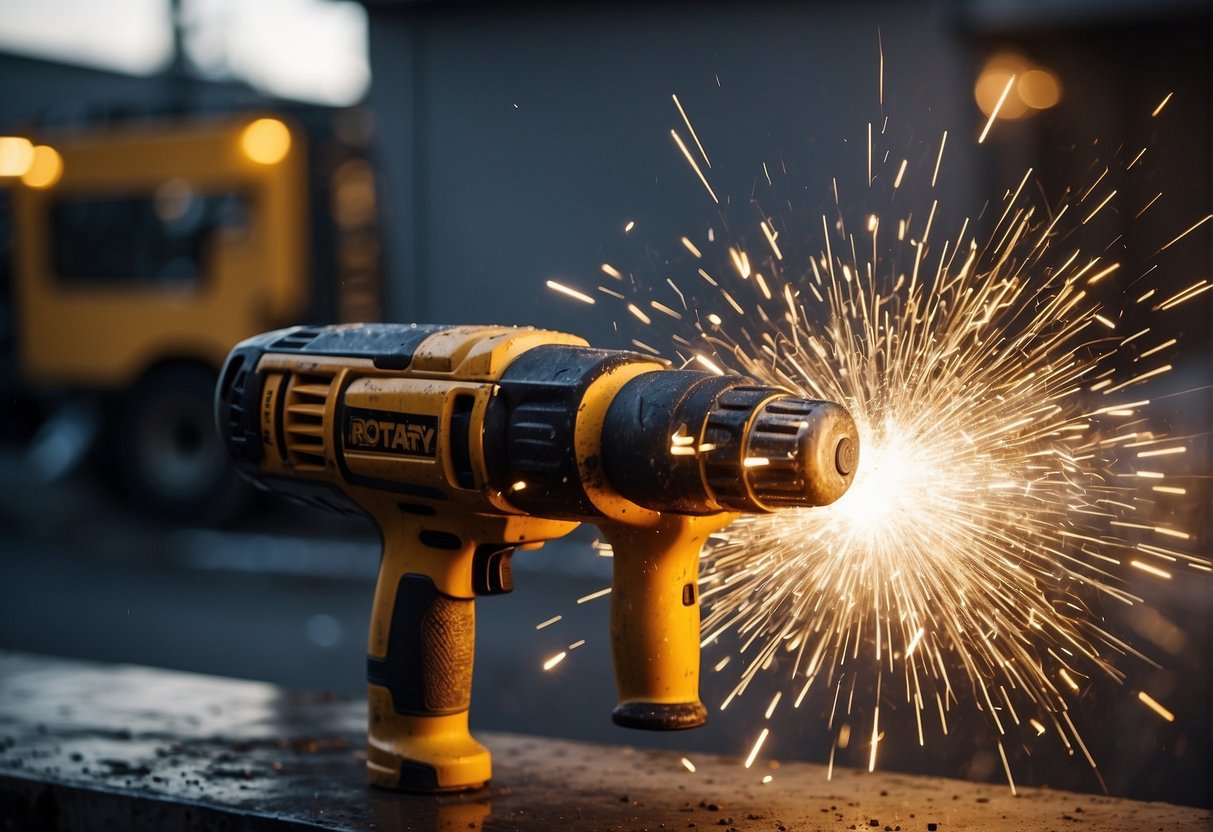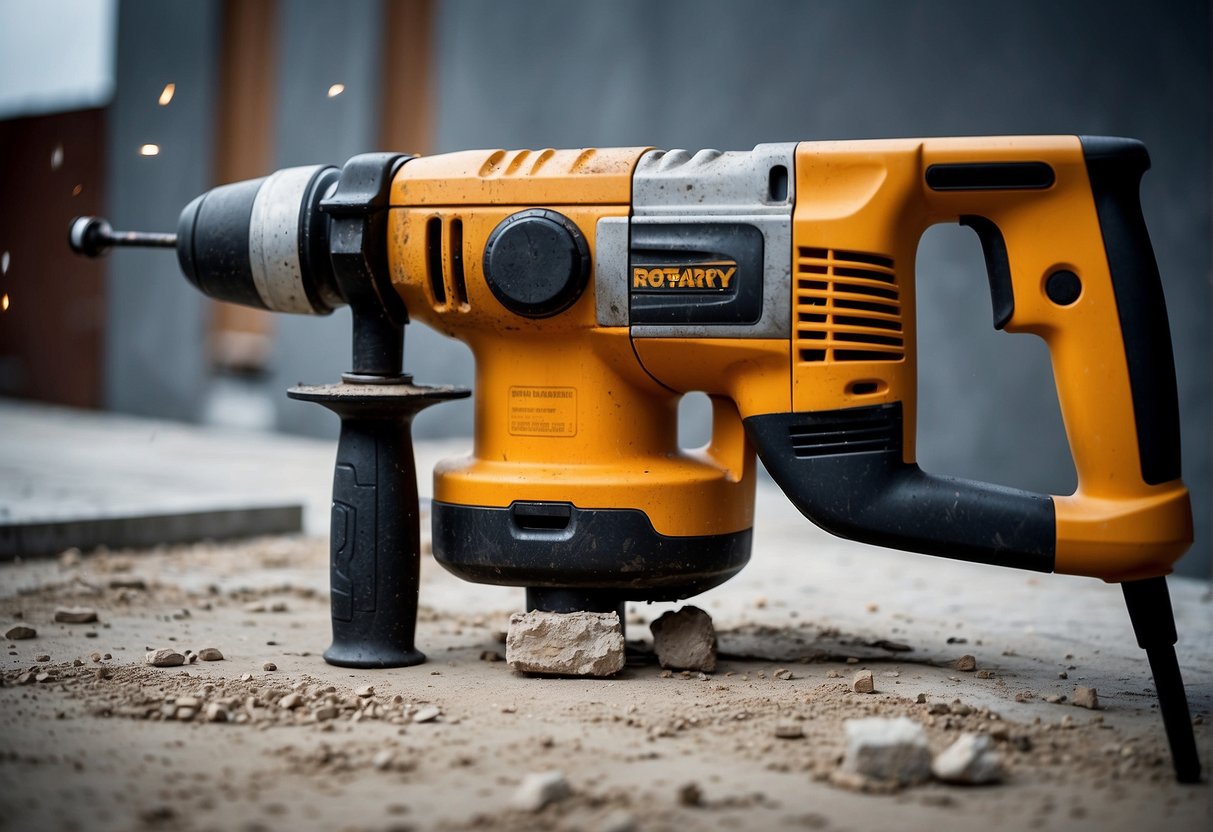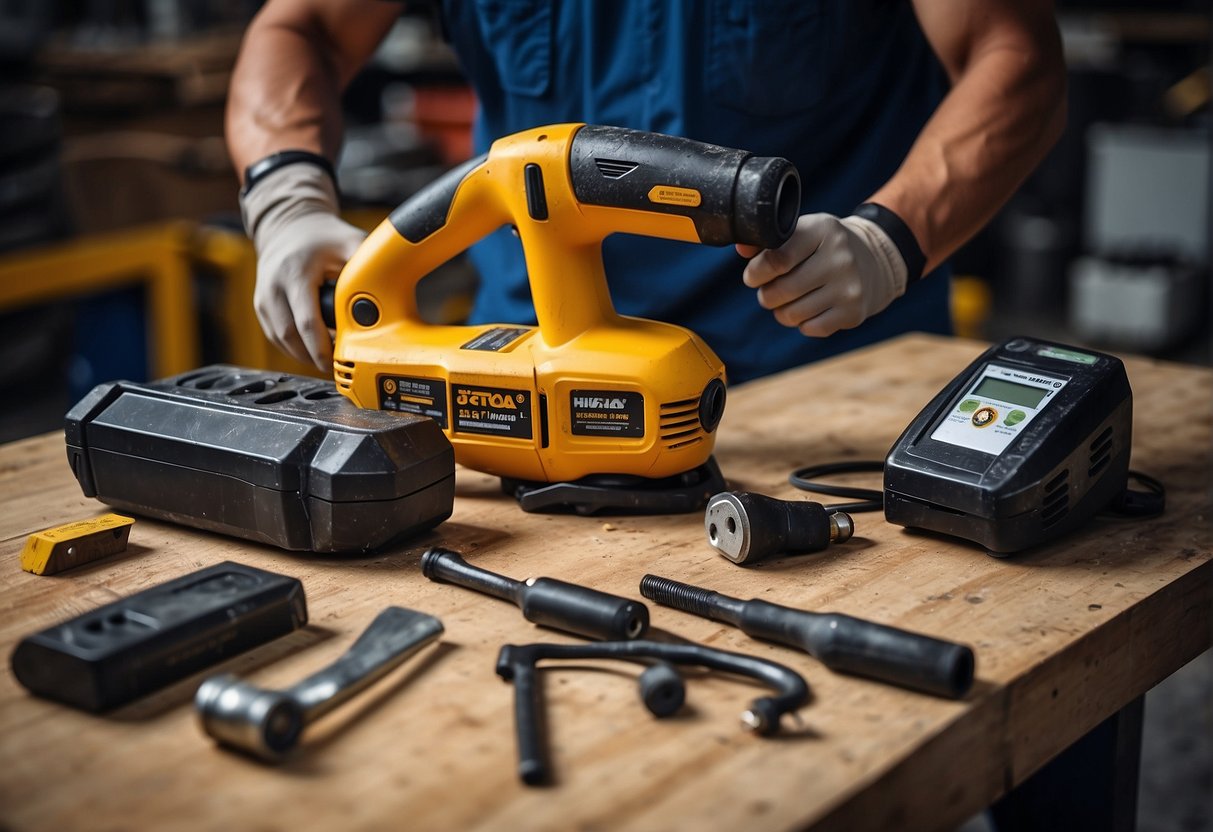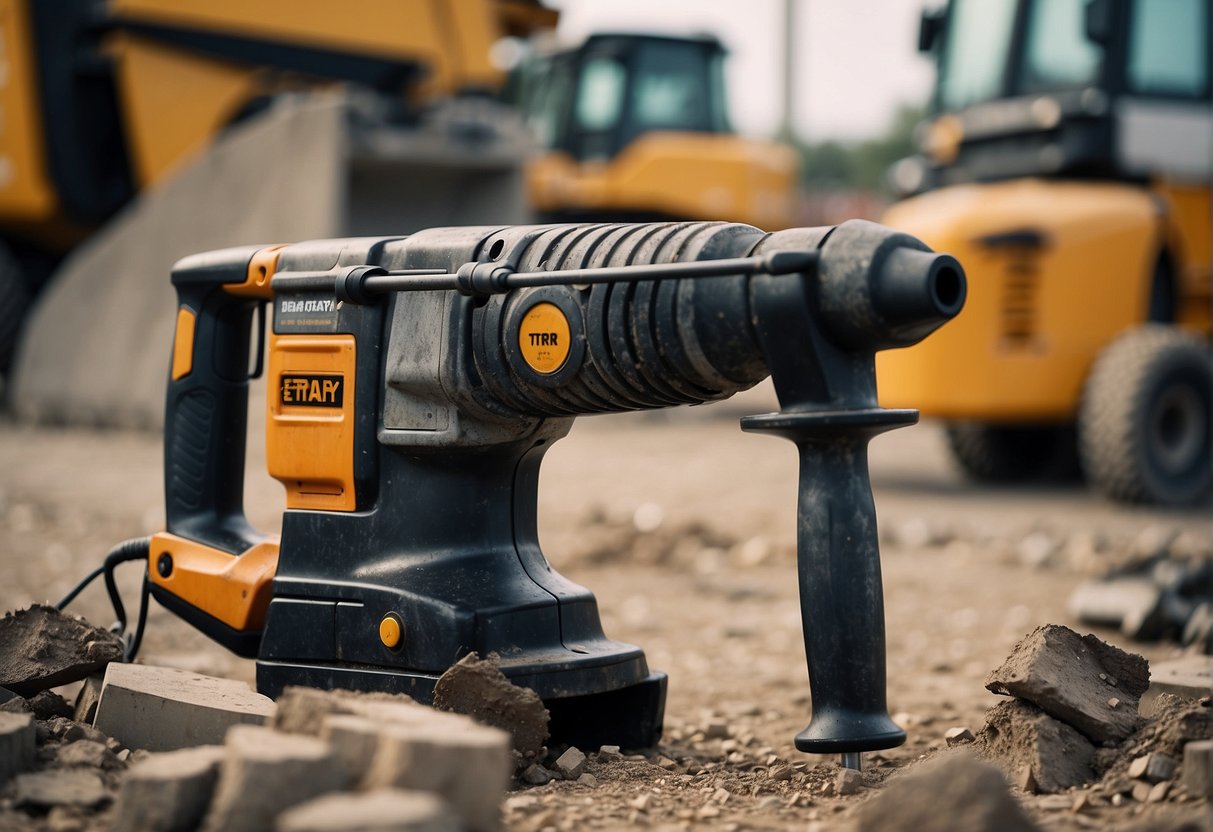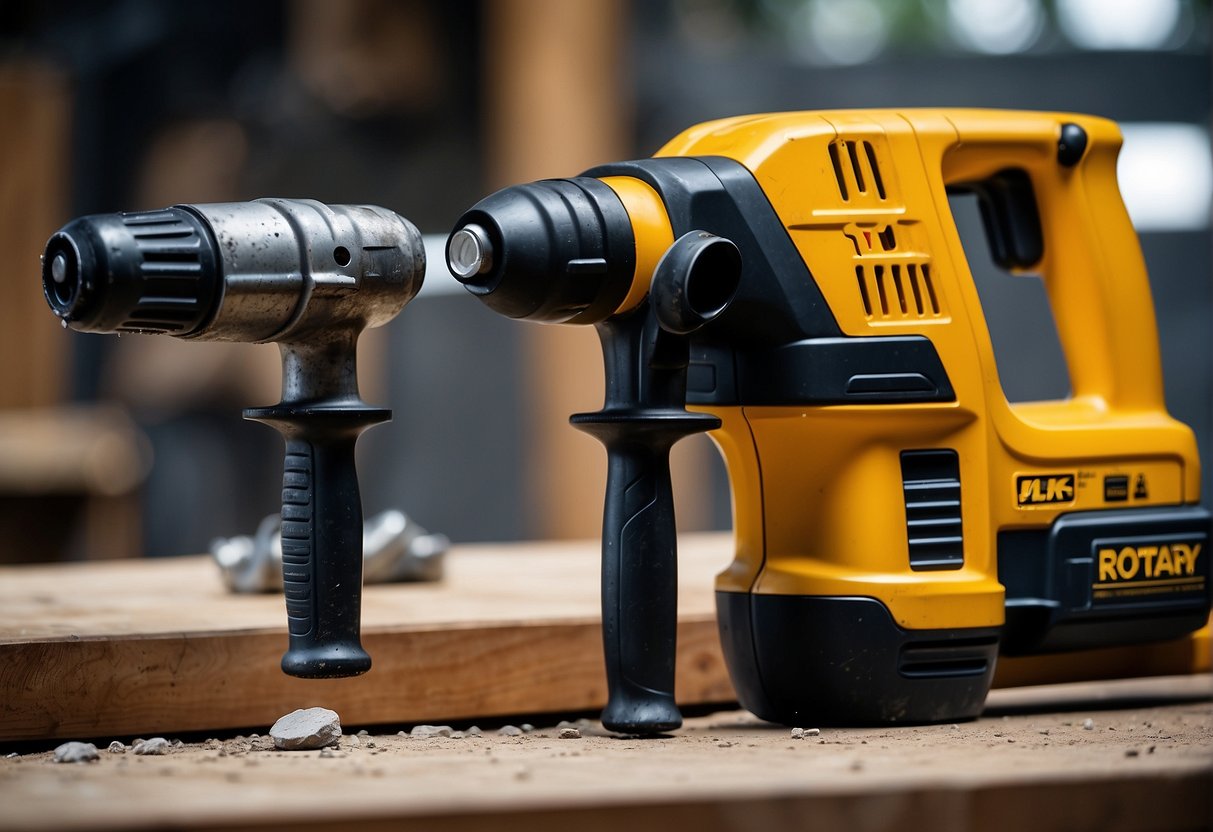Rotary hammers and demolition hammers are powerful tools that are commonly used in construction and renovation projects. Both of these tools have their unique features and benefits, making them suitable for different applications. In this article, I will compare rotary hammer vs demolition hammer to help you understand the differences between these two types of hammers and choose the right one for your project.
Rotary hammers and demolition hammers are often confused with each other, but they are different in terms of their design, functionality, and applications. Rotary hammers are designed to drill holes in concrete, masonry, and other hard materials, while demolition hammers are used to break up concrete, asphalt, and other tough materials. Understanding the differences between these two types of hammers is crucial to determine which one is best suited for your project.
Key Takeaways
- Rotary hammers are designed for drilling holes in hard materials like concrete and masonry, while demolition hammers are used for breaking up tough materials like concrete and asphalt.
- Performance and power considerations are important when choosing between rotary hammers and demolition hammers.
- Usability and convenience features, as well as cost and investment analysis, are also important factors to consider when choosing between these two types of hammers.
Understanding Rotary Hammers and Demolition Hammers
As a professional handyman, I have often come across situations where I needed to break through concrete or tough surfaces. To do this, I have used both rotary hammers and demolition hammers. In this section, I will explain the design and mechanism of these two types of hammers and highlight their key differences.
Design and Mechanism
Rotary hammers and demolition hammers are both powerful tools that can be used for heavy-duty work. Rotary hammers have a piston mechanism that allows them to drill through tough surfaces. The piston in a rotary hammer moves back and forth, creating a hammering effect that allows the tool to break through tough surfaces. Demolition hammers, on the other hand, have a chisel mechanism that allows them to break through surfaces. The chisel in a demolition hammer moves up and down, creating a chiseling effect that allows the tool to break through tough surfaces.
Rotary hammers and demolition hammers also have different modes of operation. Rotary hammers have a drilling mode and a chisel mode. The drilling mode is used for drilling holes in tough surfaces, while the chisel mode is used for chiseling away at tough surfaces. Demolition hammers, on the other hand, only have a chisel mode. This means that they can only be used for chiseling away at tough surfaces.
Key Differences
The key difference between rotary hammers and demolition hammers is their mechanism of operation. Rotary hammers use a piston mechanism to drill through tough surfaces, while demolition hammers use a chisel mechanism to break through surfaces. Another key difference is the modes of operation. Rotary hammers have a drilling mode and a chisel mode, while demolition hammers only have a chisel mode.
When choosing between a rotary hammer and a demolition hammer, it is important to consider the task at hand. If you need to drill holes in tough surfaces, a rotary hammer is the better choice. If you need to break through tough surfaces, a demolition hammer is the better choice.
In summary, rotary hammers and demolition hammers are both powerful tools that can be used for heavy-duty work. They have different mechanisms of operation and different modes of operation. When choosing between these two types of hammers, it is important to consider the task at hand.
Applications and Material Compatibility
When it comes to selecting the right hammer drill for a project, it is important to consider the materials that will be worked on and the type of work that needs to be done. In this section, I will discuss the applications and material compatibility of rotary hammers and demolition hammers.
Rotary Hammers in Action
Rotary hammers are ideal for drilling into hard materials such as concrete, masonry, and stone. They are also suitable for drilling into softer materials such as wood and metal. Rotary hammers are versatile tools that can be used for a wide range of applications, including drilling holes for anchors and screws, chipping away at concrete, and breaking through tiles.
Rotary hammers are equipped with a hammer-only mode, which allows for chiseling and breaking through materials such as concrete and stone. This mode is also useful for removing tiles, breaking down thin walls, and cutting through asphalt.
Demolition Hammers at Work
Demolition hammers are designed for heavy-duty work, such as breaking through concrete, brick, and masonry. They are powerful tools that are capable of breaking through thick walls and floors. Demolition hammers are also useful for removing old tiles, breaking down walls, and cutting through asphalt.
Demolition hammers are typically heavier than rotary hammers and require more power to operate. They are not suitable for drilling holes, but rather for breaking through materials. Demolition hammers are equipped with a chisel-only mode, which allows for precise chiseling and breaking through materials such as concrete and stone.
When selecting the right hammer drill for a project, it is important to consider the materials that will be worked on and the type of work that needs to be done. Rotary hammers are ideal for drilling into hard materials such as concrete, masonry, and stone, while demolition hammers are designed for heavy-duty work, such as breaking through concrete, brick, and masonry. By selecting the right hammer drill for the job, you can ensure that the work is completed efficiently and effectively.
Performance and Power Considerations
When choosing between a rotary hammer and a demolition hammer, one of the most important considerations is performance and power. Both tools are designed to drill holes and break up concrete, but there are some key differences to consider.
Impact Force and Vibration
One of the main differences between a rotary hammer and a demolition hammer is the impact force they produce. Demolition hammers are generally more powerful and produce greater impact force than rotary hammers. This makes them ideal for breaking up tough materials like concrete. However, this increased power also means that demolition hammers produce more vibration, which can be tiring for the user.
On the other hand, rotary hammers are designed for more precise drilling and offer less impact force than demolition hammers. This makes them ideal for drilling holes in concrete, brick, and other materials. Rotary hammers also produce less vibration than demolition hammers, which can make them more comfortable to use over long periods.
Weight and Maneuverability
Another important consideration when choosing between a rotary hammer and a demolition hammer is weight and maneuverability. Demolition hammers are generally heavier and bulkier than rotary hammers, which can make them more difficult to maneuver in tight spaces. However, this increased weight can also provide greater impact force, making them better suited for heavy-duty jobs.
Rotary hammers, on the other hand, are generally lighter and more maneuverable than demolition hammers. This makes them ideal for drilling holes in hard-to-reach areas. They are also available in both corded and cordless options, which can provide greater flexibility depending on the job at hand.
In summary, when choosing between a rotary hammer and a demolition hammer, it’s important to consider the specific tasks you will be performing. Demolition hammers are ideal for breaking up tough materials like concrete, while rotary hammers are better suited for precise drilling. Additionally, weight and maneuverability should be taken into account, as well as the level of impact force and vibration produced by each tool.
Usability and Convenience Features
Handling and Comfort
When it comes to handling and comfort, both rotary hammers and demolition hammers have their own unique features. Rotary hammers are generally lighter and easier to handle than demolition hammers. They also come with a pistol grip handle that provides a comfortable grip and better control. On the other hand, demolition hammers are bulkier and heavier, which makes them harder to handle for long periods. However, they come with an auxiliary handle that provides better stability and reduces vibration during use.
Maintenance and Durability
Maintenance is an essential aspect of any tool, and both rotary hammers and demolition hammers require regular maintenance to ensure their longevity. Rotary hammers usually come with an SDS-plus or SDS-max chuck, which makes it easy to change bits and maintain the tool. Additionally, many rotary hammers come with a dust collection kit, which reduces the amount of dust generated during use and makes cleaning up easier.
Demolition hammers, on the other hand, require more maintenance due to their heavy-duty nature. They come with an SDS-max chuck, which is more durable than the SDS-plus chuck found in rotary hammers. However, due to the heavy-duty nature of demolition hammers, they require more frequent maintenance, such as lubrication of the moving parts and regular cleaning of the air filters.
In terms of durability, both rotary hammers and demolition hammers are built to last. However, due to the heavy-duty nature of demolition hammers, they tend to be more durable than rotary hammers. They can withstand the toughest jobs and provide reliable performance over time. Rotary hammers, on the other hand, are suitable for light to medium-duty jobs and may not be as durable as demolition hammers.
Overall, both rotary hammers and demolition hammers have their own unique features and advantages when it comes to usability and convenience. It is important to choose the right tool for the job based on your specific needs and requirements.
Cost and Investment Analysis
When it comes to choosing between a rotary hammer and a demolition hammer, one of the factors that can influence your decision is the cost and investment analysis. In this section, I will discuss the initial purchase and long-term value of these two tools, as well as how to choose based on specific needs.
Initial Purchase and Long-Term Value
Rotary hammers are generally more expensive than demolition hammers. If you are a DIY homeowner who only needs to use the tool occasionally, a demolition hammer may be a more cost-effective option. However, if you are a contractor who needs a heavy-duty tool for frequent use, a rotary hammer may be worth the investment in the long run.
It’s important to consider the long-term value of a tool when making your purchase. A high-quality rotary hammer can last for many years, while a cheaper demolition hammer may need to be replaced more frequently. Additionally, a rotary hammer can often be used for a wider range of tasks, making it a more versatile tool overall.
Choosing Based on Specific Needs
When choosing between a rotary hammer and a demolition hammer, it’s important to consider your specific needs. If you need a tool for heavy-duty demolition work, a demolition hammer may be the best choice. However, if you need a tool that can also be used for drilling and other tasks, a rotary hammer may be more versatile.
It’s also important to consider your budget and how often you will be using the tool. If you only need to use the tool occasionally, a cheaper demolition hammer may be a better choice. However, if you will be using the tool frequently and need a high-quality, reliable tool, a rotary hammer may be worth the investment.
Overall, the cost and investment analysis is an important factor to consider when choosing between a rotary hammer and a demolition hammer. By considering your specific needs and budget, you can make an informed decision and choose the tool that is right for you.
Conclusion
After comparing rotary hammers and demolition hammers, I have come to the conclusion that both tools have their own unique advantages and disadvantages. If you are looking for a versatile tool that can be used for a variety of tasks, a rotary hammer may be the way to go. Rotary hammers are great for drilling holes in concrete and masonry, as well as for chiseling and breaking up small areas of concrete. They are also lighter and easier to handle than demolition hammers, which makes them a good choice for DIY projects.
On the other hand, if you are looking for a tool that is specifically designed for heavy-duty demolition work, a demolition hammer may be the better choice. Demolition hammers are heavier and more powerful than rotary hammers, which makes them ideal for breaking up large areas of concrete and masonry. They are also equipped with a variable speed trigger dial, which allows you to set the best speed for your job.
In terms of pros and cons, rotary hammers are generally more versatile and easier to handle than demolition hammers. They are also less expensive than demolition hammers, which makes them a good choice for homeowners on a budget. However, they are not as powerful as demolition hammers, which means that they may not be able to handle heavy-duty demolition work.
Demolition hammers, on the other hand, are more powerful and better suited for heavy-duty demolition work. They are also equipped with a variable speed trigger dial, which allows you to set the best speed for your job. However, they are heavier and more difficult to handle than rotary hammers, which makes them less suitable for DIY projects.
Overall, the choice between a rotary hammer and a demolition hammer will depend on your specific needs and budget. If you are looking for a versatile tool that can be used for a variety of tasks, a rotary hammer may be the best choice. If you need a tool that is specifically designed for heavy-duty demolition work, a demolition hammer may be the way to go.
Frequently Asked Questions
What are the primary differences between a rotary hammer and a demolition hammer?
A rotary hammer is designed for drilling into tough materials like concrete, while a demolition hammer is designed for breaking apart concrete and other hard materials. The primary difference between these two types of hammers is the way they work. A rotary hammer uses a piston-driven mechanism to deliver a powerful blow to the drill bit, while a demolition hammer uses a powerful motor to deliver a high-impact blow to the material being worked on.
Can a rotary hammer perform the same tasks as a demolition hammer?
While a rotary hammer can drill through concrete and other tough materials, it is not designed to break apart concrete and other hard materials like a demolition hammer. A demolition hammer is much more powerful than a rotary hammer and is designed specifically for breaking apart concrete and other hard materials.
What are the advantages of using a rotary hammer over a demolition hammer for drilling into concrete?
The primary advantage of using a rotary hammer over a demolition hammer for drilling into concrete is precision. Rotary hammers are designed to drill precise holes into tough materials like concrete, while demolition hammers are designed to break apart concrete and other hard materials. Additionally, rotary hammers typically have a rotation-only setting, which makes it easier to drill holes in materials other than concrete.
Is a combination hammer more versatile than a standard rotary hammer?
Yes, a combination hammer is more versatile than a standard rotary hammer. A combination hammer can be used as a rotary hammer for drilling into concrete and other tough materials, as well as a demolition hammer for breaking apart concrete and other hard materials. This makes a combination hammer a more versatile tool than a standard rotary hammer.
How does a breaker hammer compare to a demolition hammer in terms of power and application?
A breaker hammer is similar to a demolition hammer in terms of power and application. Both tools are designed to break apart concrete and other hard materials. However, breaker hammers are typically more powerful than demolition hammers and are designed for heavy-duty applications.
When should one opt for a demolition hammer rental instead of purchasing one?
One should opt for a demolition hammer rental instead of purchasing one if they only need to use the tool for a short period of time or if they do not have the budget to purchase a new demolition hammer. Additionally, renting a demolition hammer can be a good way to try out different models and brands before making a purchase.

Hi, I’m Sal Muller of Tooltrip.com. My DIY experience led me to understand essential power tools for home projects. Tooltrip.com guides enthusiasts and professionals in choosing right tools for any job. I provide concise top tool reviews for easier, efficient DIY.

